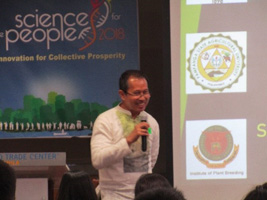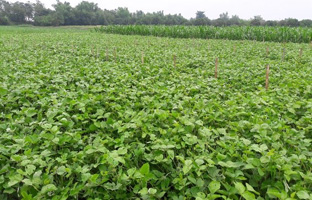 An increase of 104.7% in the yield of mungbean was realized after using a three-month old carrageenan plant growth promoter (PGP).
An increase of 104.7% in the yield of mungbean was realized after using a three-month old carrageenan plant growth promoter (PGP).
The technology was developed by the Philippine Nuclear Research Institute (PNRI). Carrageenan PGP is an oligo-saccharide produced by irradiation of carrageenan solution. It is already registered with the Fertilizer and Pesticide Authority (FPA) as an inorganic fertilizer for rice.
According to Fernando B. Aurigue, PNRI Project Leader, Senior Science Research Specialist, and a Career Scientist I, to utilize the benefits of carrageenan as fertilizer, PNRI conducted experiments using Carrageenan PGP on different varieties of mungbean. Pot experiments were done on Kulabo mungbean variety, which yielded 61.3% when sprayed thrice with freshly irradiated Carrageenan PGP. Meanwhile, an increase of 104.7% was achieved after using a 3-month-old carrageenan PGP used as foliar spray.
Carrageenan is a polysaccharide extracted from seaweeds, particularly from carrageenophytes that are abundant in the Philippines. It is an edible natural product used as dietary supplement, gelling agent, stabilizer of toothpaste, and thickener/emulsifier of ice cream, among others.
Carrageenophytes, according to Aurigue, is a marine alga that contains carrageenan. The carrageenan species that can be found in the Philippines include: Eucheuma, Hypnea, Acanthophora, and Kappaphycus. But the latter is the species commonly used as PGP.
Several on-farm trials were also conducted in different regions. In Region III, results of the study in the farm of Mr. Emerito C. Marasigan, a farmer-cooperator in Brgy. Navaling, Magalang, Pampanga, showed that NSIC Mg 2 (Pagasa 19) increased in yield from 1,353 kgs/ha to 1,805 kgs/ha or an increase of 33.4%.
In Region II, on-farm trial conducted in Brgy. Barsat Pequeño, San Mateo, Isabela using the Pagasa 7, showed an 86.9% increase in yield at ½ RRG and Carrageenan PGP compared with farmer’s practice of seed broadcasting without inoculant.
 Field trial in NSF Seed Production Area, Brgy. Bay, Los Baños Laguna using Pagasa 3 showed an increase in yield from 1,049.70 kgs/ha to 1,134.09 kgs/ha when Carrageenan PGP was supplemented to Farmer’s Practice. On the other hand, for Pagasa 7, the yield increased from 710.45 kgs/ha to 1,497.60 kgs/ha when Carrageenan PGP was supplemented to Farmer’s Practice.
Field trial in NSF Seed Production Area, Brgy. Bay, Los Baños Laguna using Pagasa 3 showed an increase in yield from 1,049.70 kgs/ha to 1,134.09 kgs/ha when Carrageenan PGP was supplemented to Farmer’s Practice. On the other hand, for Pagasa 7, the yield increased from 710.45 kgs/ha to 1,497.60 kgs/ha when Carrageenan PGP was supplemented to Farmer’s Practice.
In Region X, Pagasa 7 was used for the field trial in the Northern Mindanao Agricultural Crops and Livestock Research Complex (NMACLRC) of the Department of Agriculture in Brgy. Dalwangan, Malaybalay City, Bukidnon. When carrageenan PGP was supplemented to farmer’s practice, an increase in yield from 312 kg/ha to 392 kg/ha was realized.
The use of Carrageenan PGP for mungbean also gave the following results: more branches; more flowers which became pods; longer pods with more seeds; larger and heavier seeds; extended flowering and pod formation; increased priming from 3 to 6; and extensive root system and nodulation.
Given the said benefits, Aurigue recommended that mungbean farmers use carrageenan PGP as supplement to their practice.
The topic was presented during the National Science and Technology Week (NSTW) at World Trade Center in Pasay City. PCAARRD was one of the Councils of DOST that participated in the event.
